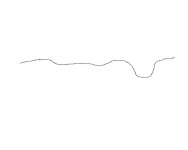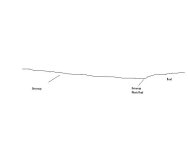flyer
Member
I've got a driveway that is about a quater mile long. It goes up a gradual slope for about 900 feet (pretty much 90 degrees to the contour, e.g., very little left/right grade, a miniscule amount of grade), then makes a 90 degree turn up to the house for the other ~300 feet. There is a shallow ditch on the right of the first 900 feet. The driveway is mostly dirt, with some stone left, although a lot of it has been "plowed" away or is in the hard earth.
I've attached a crude drawing of what the cross-section of the driveway looks like. The bottom line is, the crown is about gone, the shoulders are higher than the crown, and you can see obvious wheel ruts. The result is, when it rains and melting snow, at least one massive rut has formed (near the bottom: the water slowly builds up from the top because it doesn't get off the road!). The second (Very) crude drawing shows a view looking at the bottom of the driveway (Where it meets the road), looking from the side. As you can see, the driveway is much lower than the road, resulting in puddle of standing water for weeks after a rain.
Hopefully, that gives you the context of my issues. Now I'm looking to fix all that. I've been searching the forum and found a lot of good tips, but I'm still wondering if I'm thinking the right things for "my" project. First, I have an 855 with a FEL, but that's it. From my researching and reading, I'm leaning towards the following: buying a box blade and fitting my 3-point hitch with a top and tilt (vs. the other leading candidate, a rear blade (and possibly the top and tilt)). If the box blade is the right thing, is there a way to do it without the top and tilt or is it far more worth fitting the topand tilt?
If that is indeed the right thing to do (probably pushing $1K btw from what I can tell), then I have a lot of follow up questions since I'm unfamiliar with hydraulics and top and tilt (but don't let that lean you towards getting someone else to do it ... i know i can figure it out, just need a place to start). But first off, maybe I should leave it at the above so I can settle on the general approach before delving into that.
Thanks in advance!!
I've attached a crude drawing of what the cross-section of the driveway looks like. The bottom line is, the crown is about gone, the shoulders are higher than the crown, and you can see obvious wheel ruts. The result is, when it rains and melting snow, at least one massive rut has formed (near the bottom: the water slowly builds up from the top because it doesn't get off the road!). The second (Very) crude drawing shows a view looking at the bottom of the driveway (Where it meets the road), looking from the side. As you can see, the driveway is much lower than the road, resulting in puddle of standing water for weeks after a rain.
Hopefully, that gives you the context of my issues. Now I'm looking to fix all that. I've been searching the forum and found a lot of good tips, but I'm still wondering if I'm thinking the right things for "my" project. First, I have an 855 with a FEL, but that's it. From my researching and reading, I'm leaning towards the following: buying a box blade and fitting my 3-point hitch with a top and tilt (vs. the other leading candidate, a rear blade (and possibly the top and tilt)). If the box blade is the right thing, is there a way to do it without the top and tilt or is it far more worth fitting the topand tilt?
If that is indeed the right thing to do (probably pushing $1K btw from what I can tell), then I have a lot of follow up questions since I'm unfamiliar with hydraulics and top and tilt (but don't let that lean you towards getting someone else to do it ... i know i can figure it out, just need a place to start). But first off, maybe I should leave it at the above so I can settle on the general approach before delving into that.
Thanks in advance!!

